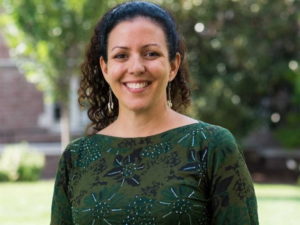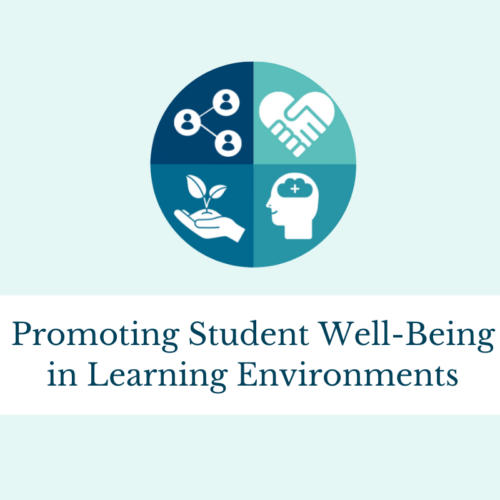Faculty Spotlight with Krista Milich, Assistant Professor of Biological Anthropology
 “Over the past couple years, it seems like many people are starting to believe that one person cannot make a difference–that changes have to be made by governments and corporations. But change doesn’t happen if no one starts it. I hope students remember that their words matter, their actions matter, their votes matters, and when they are able to make choices about where to spend their money, that matters too,” said Krista Milich, Assistant Professor of Biological Anthropology at Washington University in St. Louis. Professor Milich teaches courses including “The Pandemic: Science and Society,” a three-week immersion course for undergraduate students that delves into the intersecting aspects of life during a pandemic.
“Over the past couple years, it seems like many people are starting to believe that one person cannot make a difference–that changes have to be made by governments and corporations. But change doesn’t happen if no one starts it. I hope students remember that their words matter, their actions matter, their votes matters, and when they are able to make choices about where to spend their money, that matters too,” said Krista Milich, Assistant Professor of Biological Anthropology at Washington University in St. Louis. Professor Milich teaches courses including “The Pandemic: Science and Society,” a three-week immersion course for undergraduate students that delves into the intersecting aspects of life during a pandemic.
Professor Milich joined the College of Arts & Sciences at Washington University in 2017. Previous to her current role, she held postdoctoral positions at the University of Texas at Austin’s Department of Anthropology, Indiana University’s Kinsey Institute for Sex, Gender, and Reproduction & Department of Anthropology, and the University of Chicago’s Institute for Mind and Biology.
Professor Milich earned a PhD from the University of Illinois at Urbana-Champaign with a dissertation titled “The impact of habitat quality on female red colobus (Procolobus rufomitratus) reproduction in Kibale National Park, Uganda.” She continues to work in Kibale National Park, where she has a long-term project on red colobus monkeys. Professor Milich also collaborates with local colleagues in Uganda on a community conservation project to reduce human-wildlife conflict.
In 2020, Professor Milich was an honoree of the Emerson Excellence in Teaching Award, which recognizes educators for their leadership in and passion for teaching, their contributions to student learning, and their knowledge and creativity.
In an interview with The Center for Teaching and Learning, Professor Milich discussed the challenges of teaching biological anthropology and how she has adapted her teaching during the pandemic. She also emphasized the importance of teaching students to think critically and to realize their ability to create meaningful change in the world.
What was your path toward becoming an anthropology professor?
I’m one of those people who has wanted to do what I do ever since I was a little kid, so my path was always about achieving that goal. It was a bit complicated, though, given how much I had to figure out along the way. Being raised by a single mom who didn’t have a college education meant I had no idea how to navigate undergrad, let alone become a professor. Fortunately, I had the support of my mom and the rest of my family and had some wonderful and influential mentors along the way.
Tell me more about your primary field site in Kibale National Park, Uganda. What work are you doing there, and why did you decide on that location?
Kibale National Park is home to 13 species of nonhuman primates, as well as elephants and many other amazing species. If you grew-up dreaming of being a primatologist, Kibale is a great place to work. I study red colobus monkeys there, which are an endangered species of monkey that are also a prey species of chimpanzees. They live in large social groups, they have interesting predator-defense behaviors, and they have some flexibility in their diet that can help them cope with environmental changes. Prior to Kibale becoming a national park in the 1990s, there were parts of the forest that were commercially logged. That means that there are differences in forest structure and food availability between the areas that were previously logged and those that weren’t. I’m interested in understanding how human activity impacts the reproductive physiology and health of endangered species, and also what mechanisms may allow them to adjust to modified environments, so studying the red colobus monkeys in Kibale is an ideal situation for me.
How did you become involved in Zika virus research? How have you involved students in this research?
When Zika virus became an issue in South America, I was working on a project in the Ecuadorian Amazon studying spider monkeys and woolly monkeys. Given the reproductive consequences of infection with the ZIKV strain that was circulating in the Americas, I began to worry about the impact it would have on wild primate populations. Zika virus is similar to Yellow Fever virus, which has had devastating impacts on some nonhuman primate populations in the Americas. At the same time, certain nonhuman primate populations serve as a reservoir of YFV that then causes outbreaks in human populations. That meant that once ZIKV was introduced to the Americas, we could see similar consequences for both human and nonhuman primate health.
I involve students with a lot of my research, including having students work in my lab and go to the field with meCOVID-19 disruptions have caused issues with getting the samples I collected for the ZIKV project back to WashU. Once they arrive, I hope students will be involved with the work.
What are some of the challenges of teaching biological anthropology, and how do you address them?
I’m sure there are a lot of challenges that I’m not thinking of right now, but at the moment, I’m thinking of two major challenges: one, teaching “controversial” topics, and two, acknowledging the racist history of the discipline and racism within academia/research at large. I put the word controversial in quotes because these aren’t concepts that are controversial from an academic or science perspective, but tend to be controversial with the USA. Front and center is evolution. Evolutionary theory is the basis for all of my work and for everything that we do in biological anthropology, so making sure that students understand the concept is very important.
Depending on the student’s background, this concept can be met with some resistance. Other “controversial” topics are variation in traits across populations, including skin color, and I also teach about sexual selection and sexual strategies.
How have you adapted your teaching during the pandemic? What advice do you have for other instructors teaching during this challenging time?
For me, teaching during the pandemic has meant constantly changing strategies to deal with new challenges. I hope that isn’t the case for every instructor and that some people have been able to implement some strategies that they are carrying through all of their courses. In Spring 2020, I was teaching two classes: one a lecture-based course and the other a very hands-on research course called “Behavioral Research at the St. Louis Zoo.” Similar to everyone, I quickly uploaded recorded versions of all of my lectures for the lecture-based class and adjusted the syllabus to reduce the workload and not require any in-person or synchronous activities (as per the recommendations at the beginning). The research course involved a lot of acrobatics to adapt to the distant format, but we managed it. After that, I taught a massive 1300-person class with lots of guest speakers—a whole new skillset was developed to handle that. And then in Fall 2020, I taught a small, lab-based research course that included one-hour synchronous class meetings via Zoom and meeting students individually in the lab on separate days throughout the week and weekend. I’m hoping this Spring semester will be my opportunity to get into a better tempo—I’ll be teaching two lecture-based courses that will have asynchronous and synchronous components.
Can you share a little more about your course, “The Pandemic: Science and Society,” including your planning for it, how it went, and what you hope students took away from it?
“The Pandemic: Science and Society” was intense, but also really fun. The planning was tough—there was a lot to get sorted in a short amount of time, but I feel really happy with how it came together. And the three weeks of the course were very busy, constant work. I think it went really well. I’m looking forward to “The Second Wave of The Pandemic: Science and Society,” which I’m teaching this semester and will be at a normal pace for a class.
Who are some of the teachers who have most inspired you, and why?
Dr. Janice Bahr was my laboratory advisor in grad school and has been recognized many times over for her incredible mentorship. I feel very lucky to have learned from her. I try to emulate her mentorship style with my own students, which includes caring about everyone as individual people by actually getting to know them and mentoring them based on their specific situation. She also frames every experience – good or bad—as a “wonderful opportunity” to accomplish XYZ. I still go to her for advice. As an undergraduate, I had a work study job as a research assistant in the Department of Gerontology, working for Dr. Richard Adelman. The four years that I spent working with him opened my eyes to so much about academia that I had not been aware of. He and his wife were very welcoming to all of the students on the project.
What is your favorite class to teach, and why?
This question is tough. I love all my classes. I think for students who are interested in nonhuman primates, I definitely recommend “Primate Ecology, Biology, and Behavior.”
What do you hope students take away from your classes?
I hope students take away the ability to think critically about the information that they encounter in their everyday lives and that they remember their actions have an impact on this world. Over the past couple years, it seems like many people are starting to believe that one person cannot make a difference–that changes have to be made by governments and corporations. But change doesn’t happen if no one starts it. I hope students remember that their words matter, their actions matter, their votes matters, and when they are able to make choices about where to spend their money, that matters too.




